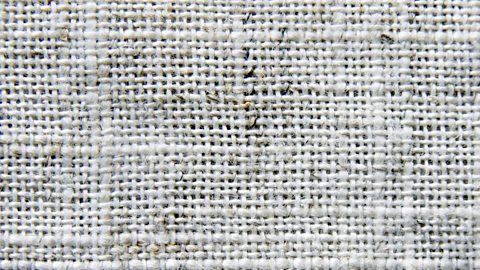Weaving and knitting
The most common fabrics used in clothing manufacture are either wovenThreads interlocked to make a fabric. or knitted, and have noticeable differences.
Woven fabrics donāt stretch unless the yarnShort threads spun to form one long thread. have been made with elastaneA durable fibre used in stretchy sportswear. fibres. Knitted fabrics do stretch, even if they are made from yarns that contain fibres that have little or no elasticity.
Woven fabrics
Woven fabrics are produced on a loomMachine for weaving threads. by interlocking yarns lying in a vertical (warp) and a horizontal (weft) direction. Weft yarns are woven over and under warp yarns, and where the weft yarns loop back to form an edge that doesnāt frayWhen a woven fabric begins to unravel when cut. The yarns that become loose are sometimes frayed on purpose for a decorative effect. , it is called the selvedge. When cut, woven fabrics will fray.
There are a number of different types of woven fabric, each with their own characteristics determined by how they are woven:
- Plain weave - The weft yarns pass over one warp yarn and then under another, with striped patterns created by varying the colours of the warpVertical threads on a loom. yarns. The thicker the yarn, the denser and heavier the fabric becomes. Commonly used to produce bed linen and school shirts.
- Twill weave - Creates a diagonal pattern to produce a heavier, more durable fabric. Jeans, work overalls and rucksacks are made from a twill weave.
- Herringbone weave - Similar to a twill weave and produces a chevron pattern. Commonly made from wool yarns and made into winter jackets.
- Satin weave - Produces a smooth shiny appearance (high lustre) because the weftHorizontal threads on a loom. yarns āfloatā over between four and seven warp yarns, allowing light to be reflected. They tend to snag easily, making the fabrics less durable, and are often used for dresses.
- Pile weave - Has a raised surface formed by introducing additional yarns into the woven construction that stand up from the surface of the fabric and are cut to create a napShort fibres on the surface of fabric.. A common example is velvet.

Image caption, Plain weave fabric
Image caption, Twill weave jeans
Image caption, Herringbone weave fabric
Image caption, Satin weave fabric
Image caption, Pile weave velvet
1 of 5
Knitted fabrics
Knitted fabrics are made from loops that interlock together, allowing the fabric to stretch considerably. This can be increased when the yarns are made from elastic fibres - they are not always made from wool. There are two types of knitted fabric:
- Weft knit - Produced when knitting with two needles, it uses one continuous yarn that produces horizontal rows of loops that interlock. It frays, can ladder and lose its shape when worn frequently. It is used to produce most garments, such as T-shirts, tights and jumpers.
- Warp knit - Produced using an industrial machine, each loop is created from a separate yarn and the loops created interlock in a vertical direction. It is firmer, lies flatter, doesnāt fray when cut and keeps its shape well. It is used to produce sportswear, including swimming costumes, and net curtains.
Image caption, Weft knitted fabric
Image caption, Warp knitted fabric
1 of 2